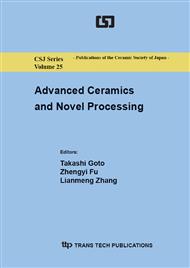p.43
p.47
p.52
p.56
p.62
p.66
p.72
p.77
p.82
Effect of pH on the Microstructure and Purity of Copper-Coated Tungsten Composite Powders Prepared by Electroless Plating
Abstract:
High-performance copper-coated tungsten composite powders were successfully prepared using electroless plating at an appropriate pH in the plating bath. The effect of pH value in the plating bath on the microstructure and purity of the coated Cu layer was studied systematically. With the increase of pH in the bath, the surface roughness, particle size and average grain size of coated Cu increased, and the particle shape gradually changed from round into square block. At pH 12–12.5, coated Cu was highly pure with very little oxygen content (less than 0.09 wt.%). The promotion effect of the increased pH on both main electroless plating reaction and side reactions causes the changes of surface morphology, average grain size of Cu and the oxygen content in the composite powders.
Info:
Periodical:
Pages:
62-65
Citation:
Online since:
June 2014
Authors:
Keywords:
Price:
Сopyright:
© 2014 Trans Tech Publications Ltd. All Rights Reserved
Share:
Citation:


